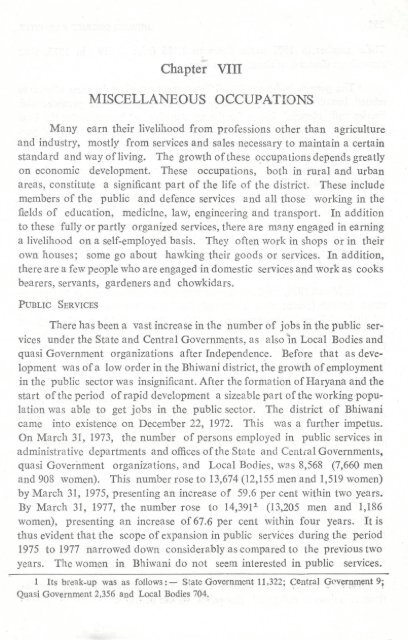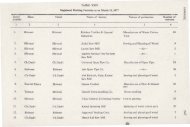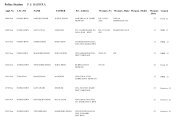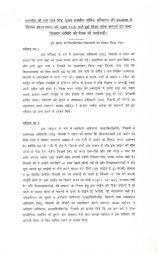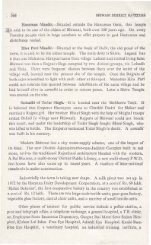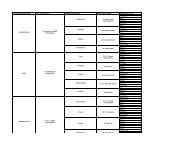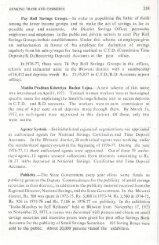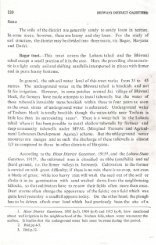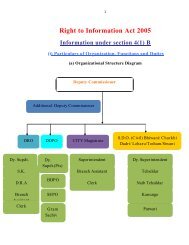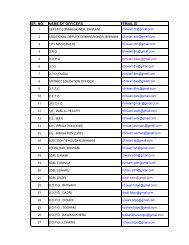chapter - ix - revenue and disaster management department, haryana
chapter - ix - revenue and disaster management department, haryana
chapter - ix - revenue and disaster management department, haryana
Create successful ePaper yourself
Turn your PDF publications into a flip-book with our unique Google optimized e-Paper software.
Many earn their livelihood from professions other than agriculture<br />
<strong>and</strong> industry, mostly from services<strong>and</strong> sales necessary to maintain a certain<br />
st<strong>and</strong>ard <strong>and</strong> wayofliving. The growth ofthese occupations depends greatly<br />
on economic development. These occupations, both in rural <strong>and</strong> urban<br />
areas, constitute a significant part of the life of the district. These include<br />
members of the public <strong>and</strong> defence services <strong>and</strong> all those working in the<br />
fields of education, medicine, law, engineering <strong>and</strong> transport. In addition<br />
to these fullyorpartly organized services,there are many engaged inearning<br />
a livelihood onaself-employed basis. They often work inshops or in their<br />
own houses; some go about hawking their goods or services. In addition,<br />
there areafewpeople whoareengaged indomestic services<strong>and</strong> work as cooks<br />
bearers, servants, gardeners <strong>and</strong> chowkidars.<br />
There has been a vast increase inthe number of jobs inthe public services<br />
under the State <strong>and</strong> Central Governments, as alsoIn Local Bodies <strong>and</strong><br />
quasi Government organizations after Independence. Before that as development<br />
wasofa loworder intheBhiwani district, the growth ofemployment<br />
inthe public sector was insignificant. After theformation ofHaryana <strong>and</strong> the<br />
start oftheperiod ofrapid development asizeablepart oftheworking population<br />
was able to get jobs in the public sector. The district of Bhiwani<br />
came into existence on December 22, 1972. This was a further impetus.<br />
On March 31, 1973, the number of persons employed in public services in<br />
administrative <strong>department</strong>s <strong>and</strong> officesoftheState <strong>and</strong> Central Governments,<br />
quasi Government organizations, <strong>and</strong> Local Bodies, was 8,568 (7,660men<br />
<strong>and</strong> 908 women). This number roseto 13,674(12,155men<strong>and</strong> 1,519women)<br />
byMarch 31, 1975,presenting an increase of 59.6per cent within two years.<br />
By March 31, 1977, the number rose to l4,39F (13,205 men <strong>and</strong> 1,186<br />
women), presenting an increase of67.6 per cent within four years. It is<br />
thus evident that the scope ofexpansion inpublic services during the period<br />
1975 to 1977 narrowed down considerably ascompared to the previous two<br />
years. Thewomen in Bhiwani do not seem interested in public services.<br />
1 Its break-up was as follows:- State Government 11,322; central gcv~m~ent 9;<br />
Quasi Government 2.356 <strong>and</strong> Local Bodies704.<br />
. .
Their number in 1977 came down to 1,186 from 1,519 in 1975, thus<br />
recording adecrease ofabout 22per cent.<br />
The persons inthe employofGovernment aregivendearness allowance<br />
related broadly to the cost of living. Class IV employees are provided with<br />
liveries <strong>and</strong> chapals. Loans for the construction of houses under the Low<br />
Income Group <strong>and</strong> Middle Income Group Housing Schemes<strong>and</strong> for the purchase<br />
ofvehicles are granted to State Government employees.<br />
In December 1970, Government decided onanex-gratia grant <strong>and</strong> other<br />
facilities forthe families oftheState Government emplOYeeswhodie whilein<br />
service. The grant isequivalent to ten times the last monthly emoluments<br />
drawn by the deceased employee subject to a minimum of Rs. 5,000<strong>and</strong> a<br />
maximum ofRs. 15,000. Other facilities include free medical aid, free educational<br />
facilities upto the degree level<strong>and</strong> Government employment to aqualified<br />
member of the family besides house rent allowance, or the retention of<br />
Government house ontheusualrent forayearafter the death oftheemployee.<br />
InMarch 1974, theState Government sanctioned anadvance toGovernment<br />
servants (except class I officers) for the celebration of the marriages<br />
of their children. The amount of this advance is 10 months payor<br />
Rs.l,500 whichever ismore subjecttoaceilingofRs. ~,OOO. Suchanadvance<br />
bears interest atthe rate charged from timeto time onanadvance taken from<br />
the General Provident Fund Account.<br />
Some Government Officers are provided rent-free accommodation.<br />
This includes the Deputy Commissioner, allthe Sub Divisional Officers(Civil)<br />
<strong>and</strong> allthe Tahsildars <strong>and</strong> Naib Tahsildars inthe Bhiwani district. Essential<br />
services like the railways, police <strong>and</strong> medical <strong>and</strong> public health are usually<br />
provided with rent-free residential accommodation. Another such category is<br />
jail execlltive staff.<br />
Since the number of Government owned houses is limited, generally<br />
only senior employees are allotted these houses against a deduction of 10per<br />
centoftheir pay. Other employeeswhohavenot beenprovided withGovernment<br />
accommodation are being givenhouse rent onthe basis ofthe population<br />
ofthe towns inthedistrict. The rate ofhouse rent admissible atBhiwani,<br />
which has been classified as a class II town, is7.5 per cent of thepay of a<br />
Government employee.<br />
Employees in public services are not restricted from formin~ associa,tions<br />
or unions to safeguard recosnised service interest •
The Jats, Ahirs, Rajputs <strong>and</strong> Gujars inthe Bhiwani district contributed<br />
a large number of recruits to the different branches ofthe defence servicesduring<br />
the two world wars. During World War II two Victoria Cross<br />
(the highest gallantry award in the British Empire) were awarded to Hav.<br />
Chhelu Ram (village Dinod) of Rajput Rifles <strong>and</strong> Subedar Richhpal Ram<br />
(village Barda) of 4th Rajputana Rifles.<br />
A large number of soldiersfromthe district fought in NEFA, Western<br />
<strong>and</strong> Eastern areas whenthe Chinese invaded India in 1962<strong>and</strong> during Pakistan<br />
hostilities in 1948, 1965<strong>and</strong> 1971. The following defence personnel received<br />
gallantry awards for distinguished services :-<br />
Recipient Resident ofvillagej Award Remarks<br />
tahsil<br />
------<br />
Jammu <strong>and</strong>Kashmir Operation, 1948<br />
Lt. Co!.Dharam BadesrajBawani Mahavir Chakra Alive<br />
Singh K.hera<br />
Lt. Co!.Brijpal BaporajBhiwani VirChakra Alive<br />
Singh<br />
SM/Hony. Capt. FatehgarhjDadri Vir Chakra Alive<br />
Jug Lal<br />
Ris/Hony. Capt. Neemli/Dadri VirChakra Alive<br />
Jage Ram<br />
SMjHony. Capt. Gudana/Dadri Vir Chakra Alive<br />
Ishwar Singh<br />
Hav. Sardar Singh Achina/Dadri VirChakra Posthumous<br />
LjHav. Mehtab Deosar/Bhiwani VirCahkra Alive<br />
Singh<br />
Naik SispalSingh BamlajBhiwani VirChakra Posthumous<br />
LjNk. Chuni Singh Tigrana/Bhiwani VirChakra Alive<br />
ChineseAggression, 1962<br />
Sub.Nihal Singh SuijBawani Khera VirChakra Posthumous
260 BH!WAN! D!STRICT GAZBTTEER<br />
Receipient Resident of villagej Award Remarks<br />
tahsil<br />
---- -- ---<br />
Pakistani Aggression, 1965<br />
Rifleman Mathan BaporajBhiwani VirChakra Posthumous<br />
Singh<br />
ChineseBorderAction, 1967<br />
Hav. Lakhmi DhananajBa wani VirChakra Posthumous<br />
Ch<strong>and</strong> Khera<br />
Pakistani Aggression, 1971<br />
Major Sher Singh JhumpajLoharu Vir Chakra Alive<br />
Naik Jai Lal GaranpurajBhiwani Sena Medal Do<br />
Sub. Lt. R.P. TigranajBhiwani Nav Sena Medal Do<br />
Singh<br />
Sqn. Leader A.N. Krishna Colony Vayu Sena Medal Do<br />
Mehtani Bhiwani<br />
Hav. Khazan Kheri BurajDadri Vir Chakra Do<br />
Singh<br />
Hav. Daya N<strong>and</strong> Ch<strong>and</strong>enijDadri Vir Chakra Posthumous<br />
Ram<br />
Major Balbir Singh Pantawas Khurdj Vir Chakra Alive<br />
Dadri<br />
Major Jai Bhagwan AchinajDadri VirChakra Do<br />
Singh<br />
Naib Risaldar Hawa NangaljBhiwani Sena Medal Do<br />
Singh<br />
Hav. Jai Lal BadharajDadri Sena Medal Do<br />
Hav. Ram Ch<strong>and</strong>er JawajDadri Sena Medal Do<br />
Naib Subedar Ch<strong>and</strong>enijDadri Mention-in-Des- Alive<br />
Chhotu Ram patches<br />
LjNaik Ved BadesrajBawani Mention-in- Alive<br />
Parkash Khera Despatches<br />
.
Naik Rameshwar<br />
Dayal<br />
ALD Jaipal Singh<br />
Subedar Dharam<br />
Pal<br />
Hav. Amar Singh<br />
Naik Dmed Singh<br />
(B.S.F.)<br />
Resident ofvillage/<br />
Tahsil<br />
Bajina/Bhiwani<br />
Dalawas/Dadri<br />
Mention-in-<br />
Despatches<br />
Mention-in-<br />
Despatches<br />
Vir Chakra<br />
Vir Chakra<br />
Alive~<br />
Posthumous<br />
Two hundred <strong>and</strong> twenty five persons of the district belonging to the<br />
armed forces were reported killed or wounded during the Pakistan Aggression<br />
of December 1971. The details are :-<br />
Tahsil Killed<br />
Bhiwani 29<br />
Bawani Khera 7<br />
Loharu 7<br />
Dadri 46<br />
----<br />
Total: 89<br />
Most ofthe ex-servicemen belong to agriculturist families. The villages<br />
which have maximum number of ex-servicemen are :-<br />
Tahsil Place Number of<br />
ex-servicemen<br />
Village/Town<br />
1 2 3<br />
---------<br />
Bhiwani Bapora 212<br />
90<br />
136<br />
TigraBa 352<br />
Dinod 163<br />
136<br />
225
261 BitIWANi DISTRICTGAzintilEi.<br />
1 2 3<br />
Bamla 167<br />
Biran 117<br />
Baganwala 63<br />
Prem Nagar 145<br />
Devsar 151<br />
Kairu : 91<br />
Dhani Mahu 107<br />
Jui~ 66<br />
Lehgan 90<br />
Mitathal 101<br />
Bhiwani 217<br />
Manheru 119<br />
Miran 108<br />
S<strong>and</strong>wa 122<br />
Dadri Achina 237<br />
Baund Kalan 179<br />
Chhapar 116<br />
Chirya 141<br />
Ch<strong>and</strong>eni 141<br />
Charkhi Dadri 111<br />
Imlota 102<br />
Jhojhu Kalan 214
2 l3<br />
Kakrauli Hukmi 107<br />
Makrana 94<br />
Misri 118<br />
Rawaldhi 90<br />
Ranila 231<br />
Sanwar<br />
144<br />
Samashpur 127<br />
Dhani-Phogat 109<br />
Barwas 76<br />
Bisalwas 29<br />
Chahar Kalan 54<br />
Chahar Khurd<br />
38<br />
Gagarwas 31<br />
Gothra<br />
45<br />
Gopalwas 38<br />
Hariawas 52<br />
Baliali 10<br />
Barsi 14<br />
Bawani Khera 191<br />
Dhanana 222<br />
Kanwari 122J<br />
Severalconcessions, have been granted by the State Government to<br />
Aqned Forces Fer§onnel <strong>and</strong> their famtI!~s,belonging to Haryana who may<br />
263<br />
.,
e killed/disabled/missing during various operations in or outside India :-<br />
(A) Ex-gratiaGrants<br />
Officers Junior Other<br />
Commissioned Ranks<br />
Officers<br />
(a) Personnel reported killed/disabled<br />
with 50per cent disability or above 7,500 4,500 4,000<br />
(b) Personnel with disability between<br />
20per cent <strong>and</strong> 50per cent<br />
(c) Personnel taken asprisoner ofwar<br />
byenemy~<br />
A lump sum of Rs. 500 <strong>and</strong> a<br />
further sum of Rs. 60 per minor/<br />
dependent child<br />
A lump sum of Rs. 500 <strong>and</strong> a<br />
further sum of Rs. 60 per minor;<br />
dependent child<br />
A sum ofRs. 1,03,150 wasdistributed as ex-gratia grant to the armed<br />
forces personnel <strong>and</strong> their families in the district during the period January<br />
18, 1974 to March 31,1977.<br />
In addition to the ex-gratfa grants mentioned above, the families/<br />
personnel concerned are given monthly pensions, as foIIows,for a period of<br />
s<strong>ix</strong>months from the date of occurrence of the casualty :-<br />
Officers Junior Other<br />
Commissioned Ranks<br />
Officers<br />
(Rs.) (Rs.) (Rs.)<br />
(a) Personnel reported killed/disabled<br />
with 50per cent disability or above 250 150 100<br />
(b) Personnel with disability between<br />
20per cent <strong>and</strong> 50per cent 200 125 75
(C) Educational Grants<br />
(1)The children of the aJove mentioned categories of personnel<br />
are entitled to free education <strong>and</strong> no feesarecharged from them<br />
in schools <strong>and</strong> colleges including professional institutions.<br />
(II) For the education of children/dependents monthly grants at the<br />
following scale are given per child/dependent 1<br />
(i) At theprimary stage 15<br />
(ii) At the Secondary stage 35<br />
(iii) At college (Arts & Science) stage, J.B.T. class <strong>and</strong><br />
stenography in ITI/Polytechnic Institute. Also to<br />
motor mechanic trainees with qualification below<br />
matric 75<br />
(iv) Motor Mechanic trainees from ITI/Polytechnic<br />
Institute whose minimum academic qualification is<br />
matric 100<br />
(v) In the case of technical <strong>and</strong> professional education 125<br />
(vi) For higher education abroad 350<br />
(vii) The children ofdeceased armed forces personnel already studying<br />
inpublic schools or getting admission to such schools after the<br />
death oftheir father inaction<br />
Income ofwidow;<br />
guardian<br />
permensem<br />
Up toRs. 600<br />
From Rs. 601to<br />
Rs.800<br />
From Rs. 801to<br />
Rs. 1,000<br />
From Rs. 1,001to<br />
Rs. 1,200<br />
Amount of<br />
education<br />
allowance<br />
per mensem<br />
(Rs.)<br />
2,400<br />
1,800<br />
1. Theexpenditure incurred inthis behalf ismet bythe Chief Secretary toGQvemment,<br />
Haryana (in the Defence Branch). The I;>eputyGommissioners are, 4ow~ver,t40<br />
Drawin~ a~d Disbursing Officers.
Thesegrants are allowedinaddition towhatever other helpthechildren!<br />
dependents may be entitled to in respect of free education, scholarship or<br />
other financial assistance especially sanctioned by the Government or an<br />
institution. 1<br />
However, educational concessions are not admissible in casesin which<br />
these are already being given by the Government of India. These are as<br />
follows :-<br />
(i) Complete exemption from tuition <strong>and</strong> other fees (including<br />
charges leviedfor theschoolbusmaintained byschool<strong>and</strong> actual<br />
farespaid for the railwayspass for students or busfa.re ascertified<br />
by the Head of Institution concerned.)<br />
(ii) Grants to meet hostel charges in full for those studying in<br />
boarding schools <strong>and</strong> colleges<br />
(iii) Full cost ofuniform where this iscompulsory<br />
(iv) Full cost of books <strong>and</strong> .stationery<br />
(III) No tuition feeischarged inclassesVItoXI(includingJ.B.T. Classes<br />
from the children of serving Armed Forces personnel or Exservicemen<br />
upto <strong>and</strong> below the rank of non-commissioned officers<br />
<strong>and</strong> Junior Commissioned Officersdrawing pension up to Rs. 100<br />
or who do not possess l<strong>and</strong> more than 5ac~es(2.02 hectares).<br />
CD) RewardstotheWinner orGallantry Decoratiens<br />
The State Government also givescash rewards <strong>and</strong> annuity, as shown<br />
below, to winners of gallantry awards, viz. Param Vir Chakra, Maha Vir<br />
Chakra <strong>and</strong> Vir Chakra, as under<br />
(a) Cash: Rs. 15,000<br />
(b) Annuity: Rs. 750for 30years<br />
The annuity isgiven for the life of the<br />
serviceman or for the life of his wife/<br />
widow (if the decoration is earned<br />
posthumously or if the recipient dies<br />
before hiswife)orfor 30years,whichever<br />
isshorter.<br />
1. From January 1971.theabove concessions have also been extended tothe personnel<br />
ofthe Border Security For••e.Territorial Army anq tqe liOllW Guards Or~aqization belOl~~<br />
to aaryaqa.
(a) Cash :Rs. 11,000<br />
(b) A::inuity :Rs. 400for 30 years<br />
The annuity isgivenfor the life of the<br />
serviceman or for the life of his wife/<br />
widow (if the decoration is earned<br />
posthumously or if the recipient dies<br />
before his Wife) or for 30years, whichever<br />
is shorter. ._--<br />
(a) Cash : Rs. 4,500<br />
(b) Annuity: Rs. 300for 30 years<br />
The annuity isgiven for the life of the<br />
serviceman or for the life of his wife/<br />
widow (if the decoration is earned<br />
posthumously or if the recipient dies<br />
before his wife)or for 30years, whichever<br />
is shorter.<br />
To the winners ofthese awards infuture, the Haryana Government has<br />
decided to give cash rewards of Rs. 22,500, Rs. 15,000<strong>and</strong> Rs. 7,000 <strong>and</strong><br />
annuity ofRs. 1,000, Rs. 400<strong>and</strong> Rs. 300respectively.<br />
The winners of Ashoka Chakra, Kirti Chakra, Shaurya Chakra <strong>and</strong><br />
Sena/Vayu Sena/Nav Sena Medal are given cash reward of Rs. 12,000; Rs.<br />
5,000; Rs. 3,500<strong>and</strong> Rs. 3,000respectively without any annuity. It has also<br />
been decided to givein future, a cash reward of Rs. 2,000to the recipient of<br />
Mention-in-Despatches without any annuity.<br />
The awardees ofParam VirChakra <strong>and</strong> Maha VirChakra (Posthumous)<br />
of Chinese Aggression 1962,Indo-Pak conflicts of 1965 <strong>and</strong> 1971 are given<br />
monetary grants ofRs. 22,500 whereas winners ofMaha VirChakra aregiven<br />
Rs. 15,000 for thepurchase of agricllltural l<strong>and</strong> or urban property. Infuture,<br />
the recipients ofParam Vir Chakra <strong>and</strong> Maha Vir Chakra willbegivenmonetatS'grant<br />
at the rate ofRs. 1,00,000<strong>and</strong> Rs. 50,000respectively.<br />
These rewards/annuities are giventothe members ofthe Armed Forces<br />
of all ranks belonging to Haryana. 1 These benefits are in addition to other<br />
1. The personnel ofthe Border Security Force, Territorial Army <strong>and</strong> theHome Guards<br />
who mlY be awarded such gallantry" decorations have also been made entitled to similar cash<br />
rewards-<strong>and</strong> annuity.
ex-gratia grants that may beadmissible otherwise. In caseofmore than one<br />
gallantary decoration, the awardee isentitled to full cash rewards for each<br />
decoration separately. In the case of posthumous decoration, the rewards/<br />
annuities are given as under :<br />
(i) Fifty per cent is given to the widow/dependent children with<br />
immediate effect.<br />
(ii) Fifty per cent is given to the parents provided they were dependent<br />
onthe recipient ofthe decoration. Otherwise this por<br />
tion of the reward/annuity is given to the widow/dependent<br />
children.<br />
(iii) Where widow/dependent children <strong>and</strong> dependent parents do<br />
not exist,the payment ofcash rewards <strong>and</strong> annuity ismade to<br />
the dependent brother(s) <strong>and</strong> sister(s)provided theywereresiding<br />
with the deceased personnel during his lifetime <strong>and</strong> in the case<br />
of females, annuity isto be paid till her/their marriage.<br />
(iv) Where the deceased personnel is survived by his dependent<br />
parents only, then parents are given 100 per cent of suchgrant,<br />
etc.<br />
Five per centvacanciesinClassI<strong>and</strong> II posts <strong>and</strong> 28per cent of vacancies<br />
in Class III <strong>and</strong> IV posts have been reserved for ex-servicemen. This<br />
reservation is utilized in the following order :-<br />
1. (a) Disabled ex-servicemen l with disability between 20per cent to<br />
50 per cent.<br />
(b) Up to two dependents (this includes wife/widow/dependent sons/<br />
daughters) of killed/disabled ex-servicemen with disability 50<br />
'per cent <strong>and</strong> above.<br />
(c) Other ex-servicemen.<br />
2. Relaxation ineducational qualifications <strong>and</strong> age are alsoallowedto<br />
ex-servicemen for their re-employment in civil positions.<br />
These concessionsarealsoallowedtoex-servicemen bythesemi-Government<br />
organizations, public sector undertakings <strong>and</strong> local bodies.<br />
1. The expression 'disabled ex-servicemen' means ex-servicemen who while serving<br />
inthe armed forces, were disabled in operations against the enemy or indisturbed areas.
(a) Reservation of 15per cent of the plots in the Industrial Area/<br />
Industrial Development Colonies for the establishment of<br />
industries.<br />
(b) Allotment ofresidential <strong>and</strong> commercial plots to the war widows<br />
<strong>and</strong> disabled soldiers at the reserved price. Payment isreceived<br />
in instalments with a nominal interest of 2per cent.<br />
(c) State Government has given additional pension from Defence<br />
<strong>and</strong> Security ReliefFund to the widows<strong>and</strong> children (upto three<br />
children) of servicemen dying in service without being battle<br />
casualties, disabled exservicemen whose disability isattributable<br />
to service<strong>and</strong> their children at the following rates from March<br />
1, 1975 .-<br />
(ii) Junior Commissioned<br />
Officer'schild<br />
(iii) Other rank's child<br />
(iv) Childlesswidow<br />
(v) Childlessdisabled<br />
ex-servicemen<br />
Rs. 50per month up to 20years<br />
Rs. 40 per month up to 20 years<br />
Rs. 30per month up to 20years<br />
Rs. 30per month up to re-marriage or tilllife<br />
Rs. 30 per month<br />
Up to March 31, 1977,Rs. 79,278was distributed to 58families of the<br />
Bhiwani district.<br />
Two funds, (1) Post War Services Reconstruction Fund, <strong>and</strong> (2)<br />
Special Fund for Reconstruction <strong>and</strong> Rehabilitation of Ex-servicemen<br />
have been created bythe Government ofIndia for the v,.elfare of ex-servicemen<br />
<strong>and</strong> their dependents.<br />
Post War Serv;ces Reconstruction Fund.-This fund was raised during<br />
World War II for the benefit ofex-servicemen of <strong>and</strong> below the rank<br />
of non-commissioned officers<strong>and</strong> their dependents. The money from which<br />
the fund had been built wasto beused for the collectivebenefitofthose who<br />
had served in the ranks or as non-combatants in the Defence Services during<br />
World War II or thereafter. The purposes for which the fund is being<br />
utilized<br />
(a) Grant of stipends to the sons/wards of beneficiary ex-servicemen
(b) Medical relief to T.B. <strong>and</strong> Leprosy patients<br />
(c) Purchase of sewing machines for widows/wives of beneficiaries<br />
<strong>and</strong> disabled ex-servicemen (in extremely deserving cases)<br />
(d) Construction <strong>and</strong> maintenance of Sainik Rest Houses<br />
(e) Maintenance allowance to destitute ex-servicemen in the Exservicemen's<br />
Home at K<strong>and</strong>aghatjJullundur<br />
(ft Maintenance charges of ex-servicemen trainees in the Queen<br />
Mary's Technical School for disabled Indian Soldiers, Kirkee,<br />
Poona ~<br />
(g) Grant to Haryanvi students, sons/wards of ex-servicemen studyingin<br />
Punjab Public School, Nabha<br />
(h) Maintenance ofinformationrooms attached withDistrict Soldiers',<br />
Sailors' <strong>and</strong> Airmen's Boards<br />
(i) Grant for re-union of ex-servicemen<br />
Special Fund for Reconstruction <strong>and</strong> Rehabilitation ofEx-servicemen.-<br />
This fund wascreated in 1964. The nucleus ofthe fund consists ofcontributions<br />
from the Government of India from the Defence Budget, the Defence<br />
Fund <strong>and</strong> matching grants made by the State Government. The objects of<br />
the fund are :<br />
(a) to award stipends to ex-servicemen for technical, managerial,<br />
vocational or agricultural training at a recognised training institution<br />
;<br />
(b) to sanction grants or loans to co-operative societIes, or other<br />
associations of ex-servicemen, for schemes <strong>and</strong> projects of resettlement<br />
that is to say horticulture, animal husb<strong>and</strong>ry, industry,<br />
transport <strong>and</strong> the like;<br />
.(c) to sanction scholarships or grants to dependents of ex-servicemen<br />
for higher studies in India beyond high school or higher<br />
secondary stage, in technical, vocational or agricultural education;<br />
j f1<br />
(d) to sanction expenditure on special measures of collectivenature<br />
for the maintenance of old <strong>and</strong> destitute ex-servicemen or<br />
widows of ex-servicemen;
(e) to grant loans to individual ex-servicemen for starting industriei<br />
or business undertakings; <strong>and</strong><br />
J<br />
271<br />
(f) to do all other things to promote measures for the benefit ofexservicemen<br />
<strong>and</strong> their dependents.<br />
The income from the fund isbeing mainly utilisedfor grant ofstipends<br />
to ex-servicemen/their dependents <strong>and</strong> grant ofloans to ex-servicemenfor their<br />
rehabilitation. Ever sincethe operation of the fund in the State, an attempt<br />
has been made to make clear cut demarcation in regard to the benefits to be<br />
given to ex-servicemen/their dependents from the Special Fund/Post War<br />
Services Reconstruction Fund in order to avoid over-lapping <strong>and</strong> duplication.<br />
Loans are being granted from the Special Fund only. Stipends to ex-servicemen/<br />
their dependents eligibleunder the Special Fund Scheme are also being<br />
given from the Special Fund. Dependents with academic qualification of<br />
Matric/Higher Secondary for technical, vocational or agricultural education<br />
are granted stipends from the Special Fund whereas under matric dependents<br />
studying in the I.T.I.s <strong>and</strong> for general education are given stipends from the<br />
Post War ServicesReconstruction Fund.<br />
EDUCATIONALPERSONNEL<br />
was<br />
During 1976-77,the number of school teachers in the Bhiwani district<br />
Male Female Total 'b'i<br />
---- ----<br />
Trained Un- Trained Untrained<br />
trained<br />
High/Higher/Multipurpose<br />
Post Basic<br />
Trained Un- ~<br />
trained:<br />
--- ---<br />
Schools 1,700 22 350 3 2,050 25<br />
Middle/Senior Basic<br />
Schools 518 134 2 652 2<br />
PrimaryIJunior<br />
BasicSchools 913 241 1,154<br />
Total: 3,131 22 725 5 3,856 27<br />
Teachers in high/higher secondary schools Were 53.4 per cent of the<br />
.total number of teachers, whereas inmiddle/senior basic shools <strong>and</strong> primaryl<br />
junior basic schools the percentage was 16.8 <strong>and</strong> 29.7 respectively. AccordjD~<br />
to qualifications, 26.6 per cent of t!l9 teachers were graduates, 73.4 per
cent either matriculates or under matriculates or under graduates. The number<br />
of untrained teachers was ne;;ligible. The qualification details are :<br />
Degree<br />
Inter/Matric/N on-matriculates<br />
Males Females Total Percentage<br />
to<br />
total<br />
912 120 1,032 26.6<br />
2,241 610 2,851 73.4<br />
3,153 730 3,883 100.0<br />
Women teachers comprised 18.8 per cent ofthe total number. Social<br />
conditions do not encourage unmarried girlsparticularly to go for work in<br />
village schools. Even male teachers tend to reside in nearby urban areas<br />
because ofthe scarcity of suitable residential accommodation <strong>and</strong> other facilities<br />
in the villages. In these circumstances, teachers living away from their<br />
place ofwork cannot make afullimpact on the lifeofthe villagecommunity.<br />
The pay scalesof teachers inprivate institutions are the sameas ofthe<br />
teachers in government institutions. The scales ofpay of teaching personnel<br />
in the privately managed institutions were revised
(I) PUBLIC WORKS DEPARTMENT<br />
(a) Public Health<br />
1. Public Health Circle, Bhiwani<br />
2. Public Health Division No.1, Bhiwani<br />
3. Public Health Division No. II, Bhiwani<br />
(b) Buildings <strong>and</strong> Roads<br />
2. Bhiwani Irrigation Division, Bhiwani<br />
3. Hisar Division, W.J.c., Hisar<br />
4. Western Yamuna (Jumna) Canal West Circle, Rohtak<br />
5. Hisar Bhakta Canal Circle, Hisar<br />
6. Jui Canal Division, Bhiwani<br />
1. Theirrigation circles/divisions donot coincide with the boundaries ofcivildistrict<br />
but are determined by th~ irrigation channels which these administer. The list, therefore.<br />
incIud.esalltheoffices ofIrrigation Department concerned with the Bhiwani distri~t. althou~<br />
som~ 0f th~m are locat~d outside the district.
1. Haryana State Electricity Board Operation Division, Bhiwani<br />
2. Haryana State Electricity Board Construction Division,<br />
Bhiwani<br />
3. Haryana State Electricity Board Operation Division, Charkhi<br />
Dadri<br />
A few persons also work as contractors, architects <strong>and</strong> surveyors.<br />
Some engineers have been employed by the textile industry. The<br />
district has the unique distinction of having the only Technological Institute<br />
of Textiles in the State located at Bhiwani, which imparts training in tex.tile<br />
engineering.<br />
TRANSPORT<br />
Transport requires the services of people working on railways, buses,<br />
motor vehicles,tempos, rickshaws, tongas, bullock carts <strong>and</strong> camel carts. In<br />
1961,1,814persons were employed inallthese transport activities. The number<br />
rose to 2,463in 1971. In March 1977,the number rose to 3,274.<br />
After the Partition, the rickshaw appeared on the scene. Most of<br />
the men engaged in pulling rickshaws get these on hire <strong>and</strong> pay Rs. 2to<br />
Rs. 3a day to the owners. Their economic condition is not satisfactory<br />
since on an average they earn onlyRs. 200to Rs. 300per mensem. Rising<br />
prices have affected adversely this section of the people. Banking agencies<br />
have financed some rickshaw pullers in purchasing rickshaws.<br />
Asfor tongas, their number is few in this district. The dem<strong>and</strong> is<br />
no longer brisk inth~ urban areas ofthe district duetothe ready availability<br />
of rickshaws atcomparitively lower rates; the cost<strong>and</strong> maintenance ofa rickshaw<br />
ismuch smaller; the rickshaw also takes the passenger to his residence<br />
evenin narrow lanes. Tongas are used for longer distances into the<br />
country-side. The use of passenger tempos has gained popularity in recent<br />
years again at the cost of the tonga.<br />
The economic <strong>and</strong> social status of Government transport employees<br />
ismuch better than that of rickshaw pullers <strong>and</strong> tonga drivers. There have<br />
been remarkable changes in transport activities after the formation of the<br />
new district of Bhiwani. The number of buses <strong>and</strong> routes have increased.<br />
.'(his has adversely affected the number as wellas income of tempo owners.<br />
.-At present the number of three-wheeled tempos carrying passengers is only
70in the district. Before the reorganization of the district this number was<br />
higher. Thenumber of four wheeledtempos, whichcarrygoods from oneplace<br />
to another, isabout 75inthedistrict. Thistype of vehicleiscalledMatador.<br />
It has been gaining much popularity ingoods transport. These metadors are<br />
mostly financed by the banks.<br />
Transport workers, Drivers, Conductors, Cleaners, etc., are employed<br />
both in the public <strong>and</strong> private sectors.<br />
Barbers.-Their number in March 1977 was2,750 inthe district. This<br />
also included hair dressers <strong>and</strong> related workers. In urban areas the old<br />
practice ofa family barber isalmost extinct. People pay barbers for service<br />
at home or goto a hair cutting saloon. Hair cutting charges varyfrom Re. 1<br />
toRs. 1.25 <strong>and</strong> shaving chargesfrom 30to40 paise. The barbers inBhiwani<br />
town havetheir ownunion which enjoins upon itsmembers tofollow certain<br />
rules <strong>and</strong> regulations in economic <strong>and</strong> social ;matters.<br />
In villages, however, the old practice of a fa~ily barber is in vogu:.<br />
H; can still b~ s~n at social ceremonies <strong>and</strong> otht:rwise. He attends his<br />
yajmans (patrons) at their residence <strong>and</strong> gets remuneration in kind at harvestingtime.<br />
The wifeofthe barber callednain does some sort ofhair cleaning<strong>and</strong><br />
hair dressing for women invillages<strong>and</strong> her presence on certain social<br />
<strong>and</strong> religious ceremoniesis necessary. In old timesthe nai (barber) used to<br />
be a messenger from the bride's family to the bridegroom's family <strong>and</strong> vice<br />
versa. He played a veryimportant role inthe arrangement ofmarriages, <strong>and</strong><br />
the barber's wife (nain) usedto accompany the bride after the marriage to her<br />
in-laws. This pratice has since fallen into diSUse.<br />
Washermen.-In March 1977, their number was 274 (218 men <strong>and</strong> 56<br />
women). It included dhobis, launderers, drycleaners <strong>and</strong> pressers. Washermen<br />
mostly servetheurban areas; thevillagersdotheir own washing. Washermen<br />
collectclothes fromthe residenceoftheir customers <strong>and</strong> generally charge<br />
30'paiseper article ofclothing. However, the chargesfor a bed-sheet, khes;<br />
carpet are almost double orthree timesthisrate. The launderers run regular<br />
shops <strong>and</strong> do not undertake home delivery. They charge higher rates than<br />
the dhobis. Their quick <strong>and</strong> efficientservice ensures good customers. The<br />
laundry owners either USewashing machines oremploy dhobis for washing <strong>and</strong>
J<br />
BIDW ANI DISTRICT GAZllT'tEER<br />
additional persons for ironing. 'The laundry business has affectedthe common<br />
dhobi who often prefers employment with a launderer. They switch<br />
over to dry cleaning in winter. Dry cleaning has no doubt b~come a profitable<br />
businessasthere are asmany as 137 persons engagedinthis business.<br />
An automatic st~am pressing plant setup byJug Mug Dry Cleaners, Sarai<br />
Chopta, Bhiwani, isthe latest addition to this trad~. The drycleanerscharge<br />
according to a scheduk of rat~s,shown below,f<strong>ix</strong>ed bytheDistrict Bhiwani<br />
Dry Cleaners Association, Bhiwani<br />
Gents Suit(woollen)<br />
Gents Coats (woollen)<br />
Gents Pants (woollen)<br />
Shawl,Jersey,Jacket Shirt, Baby Coat (wooll~n)<br />
Blank~t(woollen)<br />
Ches~r (woollen)<br />
LadiesSuit (woollen)<br />
Mumsf l(woollen)<br />
Achkan (w
complete change in the urban areas <strong>and</strong> the people increasingly wear modern<br />
types of clothing, once considered we
Their number on March 31, 1977,in the Bhiwanidistrict was only<br />
335,of whom 105werewomen. With increasing development, the district<br />
hasmore servantsin evidencenow.<br />
A domestic servantispaid betweenRs.50<strong>and</strong>Rs.80per monthplus<br />
board <strong>and</strong> lodging. At marriages,or otherimportant festivalsorceremonies,<br />
theyare paid both incash<strong>and</strong> kind. The Indian situtation<strong>and</strong> atmosphere<br />
donot usuallyfavourspecialisedjobs. A single domestic servantengagedin<br />
ahouseholdmayberequiredtopurchaseeatablesinthe market,cookfoodat<br />
home,cleantheuseddishes<strong>and</strong> plates,scrubutensils,sweepthehouse, make<br />
the beds<strong>and</strong>infactdoanythingelseatthe biddingofthemaster. Somewomen<br />
also workaspart-timedomestic servantsinanumberofhousesfor cleaning<br />
utensils,sweeping<strong>and</strong> helpingthehouse-wivesintheir dailychores. Sucha<br />
part-time domestic workergets about Rs. 15to20 permonth.<br />
In urban areas,theuppermiddleclass<strong>and</strong>more well-to-dopeopleoften<br />
employdomestic servants. Ifboththe partnersareinservice,adomesticservantis<br />
employedtolookaftertheirhouse<strong>and</strong>children. Inruralareas,hardly<br />
anyfamilyemploys a servantfordomesticwork. Most ruralwomenattend<br />
to their domesticwork themselves. The halis besidesattending to agricultural<br />
operations,do domestic choresfor their masterS'. Thesepersons, who<br />
are generallyl<strong>and</strong>less labourersarepaid at f<strong>ix</strong>ed proportion of the harvest<br />
(about 1/5thofthe total harvest).<br />
SELF-EMPLOYED PERSONS<br />
The canvasfor work of self-employed personsiswide. It includes<br />
julahas (weavers), mochis (cobblers), sweepers, thatheras (utensil makers),<br />
shoe makers,potters, bullock-cartdrivers,h<strong>and</strong>-cart pullers,hawkers,pvndas<br />
(priests)a:ndallpersonswhoworkfortheirlivingbyprovidingtheirindividual<br />
servicesorgoodsondem<strong>and</strong>. Thereareshopsofallkinds, halwai shops,pan<br />
bidi shops,shops manufacturingor/<strong>and</strong> sellingaeratedwater/softdrinks,shops<br />
dealing in grocery,vegetables<strong>and</strong> fruit shops. Bakeriesselltheir products<br />
directly or through agents. Goldsmithsmanufacture gold <strong>and</strong> silverornaments.<br />
Shops dealingingeneral merch<strong>and</strong>ise,oilmen's stores<strong>and</strong> consumer<br />
goods <strong>and</strong> novelitiesalso cater to varying needs. Changingconcepts <strong>and</strong><br />
circumstances make scope for new occupations. Take for example,the<br />
public eatinghouses. The growing habit of eating outside has ledto<br />
theestablishment ofa largenumberof tea stalls, snack bars <strong>and</strong> dhabas.<br />
Like-wise,a desiretowear st<strong>and</strong>ardisedclothes hasprompted theopeningof
shops dealing in ready-made garments. There are 25 shops of ready-made<br />
garments in the district. The incrp3.singuse of bicycles, auto-cycles, cyclerickshaws,<br />
scooters <strong>and</strong> motor-cars has been responsible for attracting people<br />
to take to the business of cycle <strong>and</strong> auto-repairing. Bicycle repairers are<br />
found in every nook <strong>and</strong> corner of the district. Businessisusually brisk for<br />
them all the year round. Automobile repairers are confinedalmost entirely<br />
to urban areas. There are 60suchshops in the district.<br />
The time oldjulahas tweavers), mochis (cobblers), potters <strong>and</strong> sweepers<br />
are spread throughout the district <strong>and</strong> serve both the rural <strong>and</strong> urban com.<br />
munity. Most ofthem in rural areas help familiesintheir agricultural acti·<br />
vities <strong>and</strong> perform their customary professional services on the occasion of<br />
marriages <strong>and</strong> other ceremonies. The mochi (cobbler) with equipment hang.<br />
ing bythe shoulder in abox, may usually beseenhawking for his servicesIn<br />
the streets. Cobblers usually attend tothe repair mending <strong>and</strong> recondition·<br />
ingof shoes. Others who make new shoeshave their own shops. There<br />
isa shoe-making factory ofHaryana Footwear Corporation making all types<br />
ofshoes, s<strong>and</strong>als <strong>and</strong> c1zappalsfor women ~.ndmen. The potters make ordinary<br />
vesselsmostlyfor the useof villagers. The earthen pitchers <strong>and</strong> surahis,<br />
because oftheir property to cool water, are sold inlargenumber during the<br />
sumliler season both inthe urban <strong>and</strong> rural areas. The sweepersengagedin<br />
cleaning hous-;:sinurban areas, geta fewrupees per month inaddition to one<br />
or two chapatis daily or weekly<strong>and</strong> occasionally small giftsin cash or kind,<br />
on festivals <strong>and</strong> ceremonial occasions. In recent years, owing to better employment<br />
facilities <strong>and</strong> privileges, some sweepers have been shifting over to<br />
services in Government offices<strong>and</strong> private organizations.<br />
Th.ltheras (utensil makers) <strong>and</strong> lohars (blacksmiths) of Bhiwani <strong>and</strong><br />
Loharu are reputed for their brass utensils <strong>and</strong> iron containers. The tokni<br />
(brasscouldron) of Bhiwani isa popular utensil of the area.<br />
The h<strong>and</strong>-cart p~dlars <strong>and</strong> hawkers go about the towns <strong>and</strong> villages<br />
hawking their goods. The goods whichthey sell include among other articles<br />
of daily use, vegetables, fruit, eatables, general merch<strong>and</strong>ize, crockery, cloth<br />
<strong>and</strong> toys.<br />
A typicalclassof Hindu priests (p<strong>and</strong>as <strong>and</strong> purohits) isfound scattered<br />
all over the district. They perform the customary religious practices, for<br />
the families to whIch they are traditionally attached <strong>and</strong> make living on<br />
this. D<br />
Except )n very)mall :villages, a tea-stall .ofsome kind has made its
appearance. The smaller ones,managed bya singleperson ana servingonly<br />
tea, are generally shabby. The bigger ones,which also serve other hot <strong>and</strong><br />
cold bewerages<strong>and</strong> some edibles,are more presentable inappearance <strong>and</strong> are<br />
managed by more than one person.<br />
In towns <strong>and</strong> big villages there areshops dealing ingeneral merch<strong>and</strong>ise.<br />
The goods onsale comprise toilet articles(combs,hair brushes, mirrors,<br />
etc.), soaps, oils, tooth-pastes, tooth-brushes, shoe polishes, hosiery articles,<br />
readymade garments <strong>and</strong> sundries of daily use. They have a flourishing<br />
business. With the riseinthe st<strong>and</strong>ard ofliving,there isan increasing dem<strong>and</strong><br />
for consumer goods <strong>and</strong> in fact new shops keep cropping up.<br />
Every town <strong>and</strong> bigvillageofthe district hasanumber of halwai shops.<br />
In the old days their familiar sweetmeat preparations were laddus <strong>and</strong> julebis<br />
The development ofcommunications, <strong>and</strong> anincreasing contact with the other<br />
parts of the country, have introduced some new sweetmeat preparations like<br />
gulab jamans, rasgullas, barti <strong>and</strong> various kinds of halwas. In urban areas,<br />
sweetmeats prepared from milk are more popular. These shops are often<br />
one-man units but several do employ two or three or even more persons<br />
according to requirements. This business provides employment throughout<br />
the year.<br />
.<br />
Pan-bidi stalls in urban areas are tiny booths which are a familiar<br />
sight throughout the district. These one-man units intowns, which usually<br />
sell cigarettees, alsoserveaschopals invillages. Theybecome social centres<br />
forpeople whostop tolisten toradio broadcasts <strong>and</strong> recorded filmmusic <strong>and</strong><br />
talk about current events.<br />
In the lastfewyearsbottled softdrinks havebecome popular <strong>and</strong> it is<br />
fashionable to drink these with a straw put into the bottle. Such drinks<br />
are imported from Delhi. In fact soft drinks are freely offeredat all big<br />
functions' <strong>and</strong> marriage celebrations. A few small local units at Bhiwanij<br />
Charkhi Dadri also prepare aerated drinks for local consumption.<br />
A number of grocershopsaretobe found in every locality. Although<br />
these are one-man establishments, generally ahelper is also engaged. Every<br />
town has a number of shops sellingvegetables <strong>and</strong> fruit. Enterprising persons<br />
withsmall capital carry vegetables<strong>and</strong> fruit ontheir rehariS (h<strong>and</strong> carts)<br />
<strong>and</strong> sell thesetocustomers at their doors.<br />
Itisnot unusual tocome acrossa bakery evenina small town. These<br />
have gained popularity owingt9 the dem<strong>and</strong> for their ready-made products.
Such establishments are mostly one-man units. The proprietor may engage<br />
oneortwopersons for preparing products asbread, cakes, biscuits, pasteries,<br />
etc. The bakery units selltheir products in wholesale as wellas in retail.<br />
Usuallythe grocer<strong>and</strong> hawkersbuythese products wholesale <strong>and</strong> retail these<br />
to their customers along with other articles.<br />
The ordinary goldsmith cannot afford to purchase or stock precious<br />
metals like gold <strong>and</strong> silver. These precious metals are, therefore, supplied<br />
bythe customer whoplacesorders for ornaments. However, richer goldsmiths<br />
have their own stock <strong>and</strong> they prepare ornaments even without taking the<br />
metal in advance from customers. This business gets a boost when the<br />
marriages are about.
The livingpattern ofthe people must depend ontheir occupational setup,<br />
following from the stage of socio-economic development <strong>and</strong> resource<br />
mobilization/exploitation, inIndian circumstances particularly, on the advance_<br />
of agriculture <strong>and</strong> the state of industry.<br />
The economy <strong>and</strong> life pattern of the people of the district are predominantly<br />
agro based. More than 86per cent ofthe population lives inthe<br />
rural areas,whichii'>higher than the percentage forthe State(82.3 percent).<br />
Of the 27.20 per cent of its active population engaged ingainful economic<br />
pursuits, agriculture <strong>and</strong> allied activities account for 20.3 per cent.<br />
Of the total population of 7,61,953 persons in the Bhiwani district,<br />
according to the 1971Census,2,07,235 were engaged in some kind of economic<br />
activity. The number of non-workers was 5,54,718. The ratio of<br />
workers to non-workers was27.20 :72.80,as against"thecorresponding ratio<br />
of26.44 :73.56 for the entire State. The district ranked fourth as regards<br />
the labour participation rate.<br />
Onthe basisofeconomic activities pursued, theworking population in<br />
the district has been classifiedinto nine categories as shown below :
Industrial Category Number of workers<br />
~<br />
Urban Rural Total Percentage<br />
to total<br />
Ma'le Female Total Male Female Total Male Female Total workers<br />
1. Ascultivators 2,299 142 2,441 1,11,250 10,888 1,22,138 1,13,549 11,030 1,24,579 60.11<br />
2. As Agricultural<br />
labourers 801 46 847 19,812 3,334 23.146 20,613 3,380 23,993 11.58<br />
3. In mining quarrying<br />
live stock, forestry,<br />
fishing, hunting,<br />
plantation, orchards<br />
<strong>and</strong> allied activities 374 13 387 4,642 1,009 5,651 5,016 1,022 6,038 2.91<br />
4. Athousehold industry 300 28 328 4.143 248 4,391 4,443 276 4,719 2.28<br />
5. In manufacturing other<br />
than household industry 9,067 154 9,221 3,050 186 3,236 12,117 340 12,457 6.01<br />
6. In construction 1,031 31 1,062 1,677 152 1,829 2,708 183 2,891 1.40 .<br />
= ~<br />
7. In trade <strong>and</strong> commerce 5,974 31 6,035 3,358 49 3,407 9,332 80 9,412 4.54 tl:t<br />
8. In transport, storage<br />
<strong>and</strong> communication 1,458 14 1,472 • 987 4 991 2,445 18 2,463 1.19<br />
~<br />
9. In other services 4,907 495 5,402 14,785 496 15,281 19,692 991 20,683 9.98 E tI><br />
Total: 26,211 954 27.165 1,63,704 16,366 1,80,070 1,89,915 17,320 2,07,235 100 20 (96.5%) (3.5%) (100%) (90.9%) (9.1 %) (100%) (91.6%) (8.4%) (100%) ~<br />
c>~>-l<br />
~IItt<br />
~
In the working population, males(91.6 per cent) predominate over<br />
the females(8.4per cent). However,the femaleworkers' participation· (9.1<br />
percent)is muchhigher intheruralareasthanthe femaleworkers' participation(3.5<br />
percent)inthe urbanareas. As against65.29percentinthe whole<br />
ofthe State,71.69 percentofthe working populationinthe district isengaged<br />
inagricultural pursuits. The main concentration ofsuchworkersisin the<br />
rural areas<strong>and</strong>their numberintheurbanareasisnegligible. All the remaining<br />
categoriesofworkers account for 28.31per cent only. After agriculture,<br />
other pursuits like mining,quarrying,livestock,forestry,fishing,hunting,<br />
plantation, orchards <strong>and</strong> alliedactivitiesengage the rural population.<br />
Household industrial workers arespreadalmostcent per centin the rural<br />
areas.<br />
In urbanareasthe workingpopulation is primarily engagedin manufacturing(otherthan<br />
householdindustry),trade<strong>and</strong> commerce.Theremaining<br />
categoriesinwhichthe urban workersare generallyfound are construction,<br />
transport <strong>and</strong>other services. Outofthe totalworking population in thedistrict,theurban<br />
workersaccountfor 13.11percentasagainst86.89per centin<br />
the rural areas.<br />
Itis evidentfromthesestatistics that agriculturalpursuits preponderate<br />
inthe rural areaswherecultivation ofl<strong>and</strong> isthe primeeconomic activity.<br />
Thusthe pressureofpopulation onl<strong>and</strong>isproportionately high. Asindustrial<br />
activityhasnot caughtupina bigway, thereisstillnosignificantchangein<br />
thelivelihoodpatternofthe people.<br />
Therewasconsiderable underdevelopmentinagricultureas wellasthe<br />
industrialsectorofthe economy. The first needofthisareawastoincrease<br />
irrigation facilitiesas agriculture was hitherto dependent on rainfall. The<br />
five-year plans marked an important stage towards self-reliance<strong>and</strong> selfsustaining<br />
growth. The agriculture sector wasgivenpreference. Extension<br />
ofirrigation facilitiesto the chronicallydrought affectedareas ofthedistrict<br />
received specialattention afterthe formation ofHaryana .1<br />
As farasthe industrialsectorisconcerned,therewereonlya fewneed<br />
based industriesinthedistrict inthe beginningofthepresentcentury. Saltpetre,kankar<br />
or argillaceouslimestone,turnery,threadmaking (sut), oilpressing,pottery<br />
work <strong>and</strong> a distillerywereinexistenceinthe Dadri tahsil. In<br />
Loharu, makingofcoarsecloth, rough blankets ofcamels' hair<strong>and</strong> embroidery<br />
workof woollen chadars were quitepopular. Extraction ofshora, brass
<strong>and</strong> bellmetal work <strong>and</strong> embroidery work were common intheBhiwanitahsil.<br />
Besides,four spinning <strong>and</strong> weavingmills werealso in existencein Bhiwani in<br />
1940.<br />
At the time India achieved independence in 1947, Dadri was famous<br />
for stonecarving, Loharu for the manufacture oflocks, bangles<strong>and</strong> iron pans,<br />
<strong>and</strong> there were three large-scaleindustrial units,i.e. twotextilemillsatBhiwani<br />
<strong>and</strong> one cement factory at Charkhi Dadri. The Muslim artisans left this<br />
country consequent upon Partition <strong>and</strong> the industrial art of stone carving <strong>and</strong><br />
bangle makini5received a serious set-back.<br />
While the livelihood pattern remains agro-based, a diversification of<br />
pursuits is visible,though at a slowpace. After the formation of the neW<br />
State of Haryana, the infrastructure for the development of industries in this<br />
areahasbeencreated. Variousincentiveshavebeengiventothepromising entrepreneurs<br />
to establish newindustrial units. The result isthat large industrial<br />
activity isnow possible <strong>and</strong> a number of newunits arefast coming up. Now<br />
the Bhiwani district enjoys a dominating position in the textile <strong>and</strong> stone<br />
crushing industries. During November 1, 1966 to March 31, 1977, the number<br />
of small-scale units increased from 118 to 518 <strong>and</strong> the number of largescale<br />
units increased from 4 to 8.<br />
Changes are visibleinthe entire structure ofthe economy <strong>and</strong> in the<br />
near future the livelihood pattern of the working people is likely to undergo<br />
rapid diversitywith the result that thepressure ofpopulation on l<strong>and</strong> m"ywell<br />
decre~se.<br />
The economy ofHaryana is predominantly agricultural, with 82.3per<br />
cent of the population (according to 1971 census) living in rural areas. A<br />
leveloffull employment canbeachievedonlyafter atotal greenrevolution <strong>and</strong><br />
a complete net-work ofindustrial structure, whichinturn willenablethe diversion<br />
of surplus labour force from agriculture to industry. In the Bhiwani<br />
district, the rural population ismore than 86per cent of the total population.<br />
Out ofthe total population of7,61,953, only 2,07,235 (27.20 per cent) formed<br />
the work force, ofwhich 1,48,572 (19.5 per cent)wereengagedinthe conventional<br />
sector <strong>and</strong> the remaining 58,663 (7.7 per cent) were engaged in other<br />
pursuits. In the absence of data regarding unemployment, the assessment of<br />
employment situation canonly begathered from the working of employment<br />
exchanges in the district.<br />
Employment Exchanges.-The State Directorate of Employment runs
employment exchanges inthedistricts, which register the names <strong>and</strong> qualifications<br />
of unemployed persons seeking work.<br />
A Sub-Employment Exchange was established at Bhiwani on November<br />
8, 1960. It was upgraded to the levelof a District Employment ExchangeinJuly<br />
1969. InDecember 1971,oneRural Manpower Unit wasopened<br />
at Tosham under the Bhiwani Exchange. With the formation ofBhiwani<br />
as a separate district, two more offices,Sub Office Employment Exchange,<br />
Charkhi Dadri <strong>and</strong> Rural Manpower Unit, Badhara under the Bhiwani Exchange<br />
were started inFebruary 1961<strong>and</strong> January 1972respectively. TheSub<br />
Officeat Charkhi Dadri was raised to the status of Town Employment ExchangeonJuly4,1974<strong>and</strong><br />
the Rural Manpower Unit was shiftedtoLoharu in<br />
June 1975. Thus the total number of employment exchanges in the district is<br />
four.<br />
The Employment Exchanges (Compulsory Notification of Vacancies)<br />
Act, 1952,came into force inJune 1960. It prescribes a statutory obligation<br />
on the part of all establishments inpublic as wellas in the private sector to<br />
notify all vacancies. In the private sector, provisions.of the Act apply only<br />
to those establishments which employ more than 25 or more persons. The<br />
following table shows working ofthe Employment Exchanges inthe Bhiwalli<br />
district dUrin~ 19G9-76 ;-.<br />
Year Em- Regis- Vacan- Appli- AppU- Mohthly Vacan~<br />
ploy- trations cies cants cants on number cies<br />
mentex-during notified placed thelive ofem" carried<br />
changes theyear in register ployers overat<br />
at the employ- using the end<br />
end of ment the ex- ofthe<br />
the during change year<br />
year theyear<br />
December 1969 1 4,871 5,213 1,334 1,481 10<br />
December' 1970 1 6,075 7,208 1,604 6,072 12<br />
December 1971 2 6,623 7,636 1,752 5,754 19<br />
December 1972 2 7,815 6,057 1,736 6,389 21<br />
December 1973 4 1 15,076 4,307 2,353 8,316 32<br />
December 1974 4 12,547 2,563 1,306 14,549 28<br />
December 1975 4 12,651 2,227 1,555-: 14,087 37<br />
December 1976 4 11,410 4,800 2,085 12,688 49
The problem of the unemployed in the district is complex. Generally,<br />
there is non-availability of experienced skilled work force in adequate number<br />
to meet dem<strong>and</strong>. Onthe other h<strong>and</strong>, there isaglutofnewapplicants having<br />
no work experience. On December 31, 1976,there were 12,688 applicants<br />
on the live register of Employment Exchanges of the district, whereas the<br />
number of skilled applicants seeking employment assistance was only 2,884.<br />
The rest included 8,146 non-matriculates, 2,882 matriculates, 648 under<br />
grauduates, 952graduates <strong>and</strong> 60post graduates.<br />
However, the functioning of employment exchanges in the district has<br />
improved the quality of services in the collection of employment market information<br />
<strong>and</strong> vocational guidance facilities. Asa part oftheprogramme of<br />
collection of employment market information, quarterly employer's returns<br />
are obtained from establishments inthe public sector <strong>and</strong> from employers employing<br />
10or more persons inthe private sector. These returns contain information<br />
inter-alia regarding vacancieswhichremain unfilledat the end ofa<br />
quarter due to non-availability of suitable-applicants. At the same time it<br />
provides information about the strength of establishments/concerns. On<br />
March 31, 1977,there were 279public <strong>and</strong> 59private establishments on the<br />
record of the Employment Exchanges.<br />
There is one Vocational Guidance Unit at Bhiwani, where career<br />
pamphlets, books <strong>and</strong> other usefulinformation areprovided for the benefitof<br />
students/applicants. Invitational group talks are given to students <strong>and</strong><br />
applicants by the Employment Counsellor. Career talks are given by the<br />
Vocational Guidance Counsellors to students in the schools to guide them<br />
about better careers. Individual <strong>and</strong> group counselling work isalso carried<br />
out in the Employment Exchanges. 1<br />
PRICES<br />
The major factor which affects thedistributive pattern of incomes<strong>and</strong><br />
which also determines the tempo <strong>and</strong> nature of economic development is<br />
the fluctuation in prices. Prices regulate the production <strong>and</strong> consumption<br />
economy of a region. Change in prices inthe first instance affectsthe real<br />
income<strong>and</strong> thereafter itcreatesdivelgencebetween incomesofdifferentgroups.<br />
Abrupt changesinpriceshamper the steadygrowth ofthe economy. Therole<br />
ofpricesisnot merelypassive,ofshowingindices reflectingonlythechanges in<br />
1. The occupational research <strong>and</strong> analysis <strong>and</strong> also the publication of career books<br />
<strong>and</strong> pamphlets are done by the Department of Employment at State headquarters at<br />
Ch<strong>and</strong>igarh <strong>and</strong> the Directorate General of Employment <strong>and</strong> Training, Government of India,<br />
New Delhi.
the price levels,but also active, <strong>and</strong> may cause expansion or recession in<br />
economy.<br />
Prior to World War I (1914-18), prices were generally dependent<br />
on agricultural yield.1. Since the areas, now comprising the district of<br />
Bhiwani have remained agro-based, the pricesinthe region havebeen co-related<br />
with agricUltural production <strong>and</strong> theimports of goods necessaryfor the<br />
requirements of this area. The outbreak ofthe war in1914,causeda sudden<br />
rise inpricesowingto imports beinginshort supply<strong>and</strong> agricultural production<br />
having been affectedby poor monsoons <strong>and</strong> thebad harvests of 1915-16.<br />
In1917 commenced aperiod ofdistress<strong>and</strong> hardship inwhichprices rose too<br />
rapidly to allow the economic system to adjust itself. The strain on the railways<br />
resulting from the war caused dislocation of communications so that<br />
goods from an area of plenty could not be transported to areas of scarcity.<br />
The situation worsenedfurther bythe disastrous harvest of1918closely followedbyan<br />
unparalleled lossoflife caused bythe influenzaepidemic inthelater<br />
part of 1918. These hardships brought matters to a climax <strong>and</strong> evengood<br />
harvests in 1920proved insufficient to contain the upward trend of prices.<br />
The general depression of thirties brought a big slump in the market<br />
accompanied by unemployment. The resulting downward trend inthe prices<br />
of agricultural produce created misery for the farmer.<br />
World War II broke out in September 1939. Itcreated widespread<br />
scarcity conditions in respect of many articlesof daily need. The situation<br />
was further aggravated by damage to crops by natural calamities. The<br />
Bhiwani area wasfamine stricken. Soits farmers could not deriveanybenefit<br />
from the high prices ofagricultural produce. There wasa slightrecession in<br />
pricesin 1944<strong>and</strong> 1945, but after 1945 the generalscarcity of foodgrains <strong>and</strong><br />
inflationary factors were responsible for the price levelto rise enormously.<br />
Theprice indexofcloth registeredamuch higherrisethan that offood articles.<br />
The Government enacted speciallawsfor the procurement offoodgrains <strong>and</strong><br />
to regulate the distribution of articles in short supply at controlled rates.<br />
On the Independence in 1947<strong>and</strong> consequent partition ofthe country,<br />
1. Itis difficult to giveprecisely theprices prevailing inthe Bhiwani district as awhole<br />
in the past. Since this district has been formed bycombining some areas which had in the<br />
past remlined parts ofdifferent administrative units, some idea about the retail prices prevailingl<br />
in some parts of this district may be had from Tables XXXII <strong>and</strong> XXXIII of the<br />
Append<strong>ix</strong>. The former tableshews the retail prices prevailing intheHisar (Hissar) district on<br />
the first January each year in seers n:d cthr.trnks I:er nI:ce frem 1£Glto 1932"hile l1:e<br />
latter table gives similar information about Loharu up to 1911.
economic activities suffered to a very great extent due to dislocation of the<br />
working population. A proper working force could not be developed for a<br />
longtime <strong>and</strong> this affected verybadlythegeneraleconomic condition. There<br />
wasafurther rise inteeprice level. Pricecontrol wasimposed bythe Government<br />
ofIndia inmany sectors tostablilizethe general pricelevel all over the<br />
country. The measures taken proved fairly effective<strong>and</strong> there was areasonable<br />
decline in prices.<br />
After Independence, the introduction of planning opened anew era<br />
ofprogress<strong>and</strong>development particularly inthe field of agriculture, irrigation<br />
industry <strong>and</strong> employment. Asaresult of the First Five-Year Plan (1951-52<br />
to 1955-56),agricultural production increased considerably <strong>and</strong> prices of food<br />
products fell in 1953-54. The price control on foodgrains was lifted. But<br />
the upward trend inprices started again immediately thereafter. The general<br />
scarcity of foodgrains due to harvest failures <strong>and</strong> taking up of developmental<br />
activities,with long gestation periods, gave birth tovarious Inflationary<br />
factors to boost the price level during the Second Five-Year Plan (1956-57<br />
to 1960-61). In the Third Five-Year Plan period (1961-62to 1965-66),the<br />
prices ofwheat ,barley, rice, bajra, maize,gur, tobacco, etc., increased almost<br />
hundred per cent.<br />
During the Fourth Five-Year Plan (1969-70to 1973-74), the wholesale<br />
prices registered an unprecendented upward trend. - In Bhiwani, the price of<br />
wheatwasRs. 35.00 to Rs.68.00 <strong>and</strong>Rs. 135.00per quintal in the years1960,<br />
1966<strong>and</strong> 1974respectively. Similarupward trend in the priceofgramhas also<br />
been observed during the last 15years. Priceswere generally stable during<br />
1975. The year-1976 witnessed allround declineinpricesexcept Jowar <strong>and</strong><br />
bajra. -<br />
The average wholesale harvest prices in certain selected m<strong>and</strong>is of the<br />
Bhiwani district are discussed individually to bring out clearly the fluctuations<br />
in prices in different parts of the district<br />
The market at Bhiwanihas beenfamous for itstrade infoodgrains. It<br />
is much bigger than other m<strong>and</strong>is of the district. The following table shows<br />
the average wholesale harvest prices of various agricultural commodities in<br />
this m<strong>and</strong>i during 1960 to 1976 :-
(Rupees per qujntal)<br />
~<br />
C()Jnmodity) 1960 1966 1970 1971 1972 1973 1974 1975 1976 n<br />
0Z0<br />
Wheat 35.00 68.00 87.00 83.00 91.(0 91.00 135.00 138.35 107.60 ~<br />
C':l<br />
>,).<br />
Gram 38.00 68.00 89.CO 74.00 106.00 146.00 197.QO 190.40 96.6 ~ Zl:t<br />
{I>o<br />
Maize 31.50 80.50 45.00 52.50 73.00 75.00 84.70 80.50<br />
Barley 33.50 58.80 54.50 48.50 65.CO 100.50 109.50 98.40 62.60<br />
Jowar 36.00 50.00 40.00 51.00 79.00 86.00 155.00 86.84 120.00<br />
Bajra 30.50 69.50 51.50 56.50 93.50 88.50 100.00 82.85 85.85<br />
Gur 37.00 57.60 65.00 76.00 135.60 130.65 135.00 142.45 108.68<br />
Cotton (Desi) 80.00 105.66 157.50 156.60 180.00 211.00 263.00 198.85
It shows that the prices of agricultural commodities continuously rose<br />
from1960<strong>and</strong> reacheda maximumin1974. In1970,theharvest prices decreasedexceptinthecaseofwheat,<br />
gram<strong>and</strong> gur. Thepricesofwheat, barley <strong>and</strong><br />
gram showed adecline in 1971. During 1972<strong>and</strong> 1973,the harvest prices of<br />
allthe commodities except wheat increased appreciably. In 1974,there wasa<br />
steep rise in prices of all the commodities. Prices, however, declined in 1976<br />
except those of bajra <strong>and</strong> jowar.<br />
Charkhi Dadri<br />
Except barley <strong>and</strong> cotton, the average wholesale harvest prices in the<br />
m<strong>and</strong>i of Charkhi Dadri showed a continuous rising trend since 1960right up<br />
to 1974. The price of barley declined in 1971 but recorded a steep increase<br />
thereafter. The price of cotton also fellfrom Rs. 340(per quintal) in 1971 to<br />
Rs. 294 in 1972. The details of average wholesale harvest prices In Charkhi<br />
Dadri are giveninthefollowing table :-
(Rupees per quintal)<br />
~<br />
1960 1965 1970 1971 1972 1973 1974 1975 1976 0<br />
z0<br />
~<br />
Commodity<br />
Wheat 42.20 57.00 79.50 77.75 91.50 98.50 131.00 151.10 106.6 n<br />
>-i<br />
:>c<br />
t!1<br />
Gram. 35.80 48.25 91.50 78.00 101.00 147.50 198.00 189.80 98.75 Z<br />
0fA<br />
Barley 31.05 53.50 62.50 53.00 70.50 111.50 122.50 107.00 66.10<br />
10war 11.62 62.50 47.50 47.50 94.00 85.00 140.00 83.75<br />
Bajra 14.55 52.75 54.00 55.00 70.50 92.50 190.00 84.66 87.25<br />
Gur 22.92 57.83 67.00 74.35 152.00 152.33 145.00 138.35 112.00<br />
Cotton (Desj) 67.50 217.00 320.00 340.00 294.00 360.00 420.00


